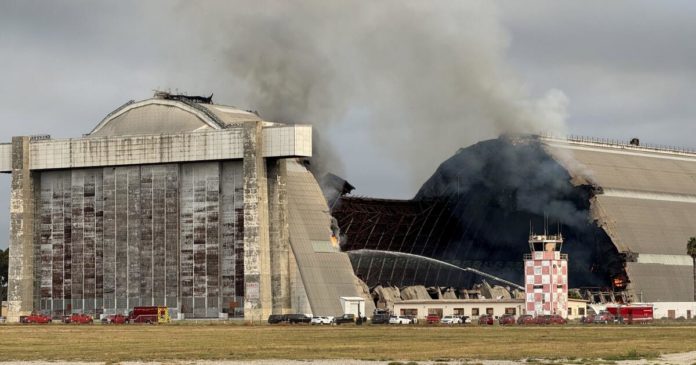A massive fire that started early Tuesday was burning the historic north blimp hangar in Tustin, an Orange County landmark that dates back to World War II.
Officials said an investigation into what caused the fire is underway.
“It’s a sad day for the city of Tustin, for all of Orange County,” Chief Brian Fennessy of the Orange County Fire Authority, which responded to the fire, said at a news conference early Tuesday.
Fire was reported near the hangar just before 1 a.m., Fennessy said, and firefighters arrived to find it “fully involved.”
Seventy OCFA firefighters on 11 engines and five fire trucks responded to the fire, which was so large and complex that officials deployed helicopters, including a Chinook used in wildfires, to drop water on the huge structure.
“That’s unheard of,” Fennessy said of deploying the aerial resources. “But we thought we would throw everything we could at it just in case we could stop it midway.”
But because of the “dynamic nature of the fire, and the imminent danger of collapse,” firefighters plan to allow the flames to collapse the mostly wooden hangar before ground crews move in to try to extinguish the fire.
The fire could burn for several hours, if not days, Fennessy said.
“It’s so deep-seated right now that it’s run up the side, and where oxygen is feeding the fire right on the edges, [it] is just eating its way back slowly,” Fennessy said.
There will be “large crashes” and a “pretty spectacular collapse” as the fire progresses and the structure fails, Fennessy said.
“We expect it to likely continue to do that possibly until [the fire] gets to the other end of the hangar,” he said.
Firefighters cannot get close to the building because the structure might collapse on them, which has made extinguishing the fire impossible, officials said. No injuries have been reported, and no other structures appeared threatened.
Tustin Police Chief Stu Greenberg said road closures are in effect on Valencia Avenue between Kensington Park Drive and Lansdowne Road, and on Armstrong Avenue between Bell Avenue and Valencia.
Debbie Baker, 70, was awakened around 1:30 a.m. to the sounds of helicopters flying above her home near the complex’s hangars. She smelled the smoke and stepped outside to see massive flames overtaking one of the giant structures.
“It’s so sad,” she said, her voice breaking with emotion. “For years those hangars welcomed us home. It’s what made this community special.”
The hangar is one of two erected by the military in 1942 as part of the now defunct Tustin Naval Air Station.
The hangars housed 12 blimps that were used for submarine patrol. Each structure is at least 17 stories high, 1,088 feet long, 297 feet wide and covers almost 300,000 square feet, according to an earlier story in The Times. It would be possible to play a basketball game, a football game and a soccer match in one building simultaneously.
The huge wooden doors, which have six leaves that weigh 26 tons to 39 tons each, fold open on steel rails like an accordion, powered by electric motors at each end. Giant concrete pylons anchor each corner of the hangars, The Times reported.
The hangars were built mostly from Oregon Douglas fir. The 2 million board feet of wood were treated with metallic salts as a fire retardant.
Many in the Tustin community had personal connections to the hangars from working on the base, Tustin Mayor Austin Lumbard said.
“This is not the end for what we call the north hangar that was envisioned,” Lumbard said. “It’s not the dignified treatment that it deserves.”
The hangars are two of the world’s largest free-standing wooden structures. Both are listed in the Register of National Historic Places.
The blimps housed there were armed with machine guns, bombs and charges to fend off submarines, The Times reported.
The base closed in 1999.
About a decade ago, there had been concerns about damage to the structures. Plans to develop the site into a regional park fell through in 2021.
Last year, Tustin began a $330,000 cleanup effort of the base — the most significant since its closure — removing large containers, scrap piles, various abandoned equipment and interior broken fencing from the site, repairing fencing along the perimeter and trimming overgrown vegetation, which could make the site prone to fires.
The city also conducted a hazardous materials assessment of the buildings and said it would regularly maintain the area. Officials said they would issue a report and consider moving forward with an abatement plan.
At the time, officials said they were exploring potential revenue opportunities for the site until a permanent plan could be developed. The city’s reuse plan could take up to two years to create, according to a city staff report. Some of the former base has already been developed into the District shopping center, office buildings and residences.
The overall plan for the former base was to turn it into a mixed-use development known as Tustin Legacy.
Former Times staff writer Ben Brazil contributed to this report.


